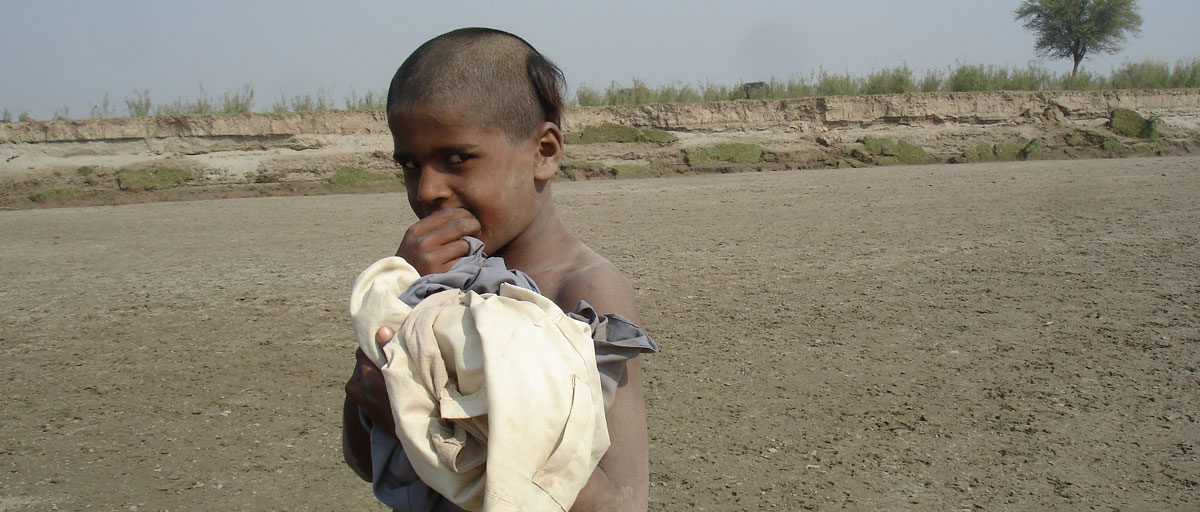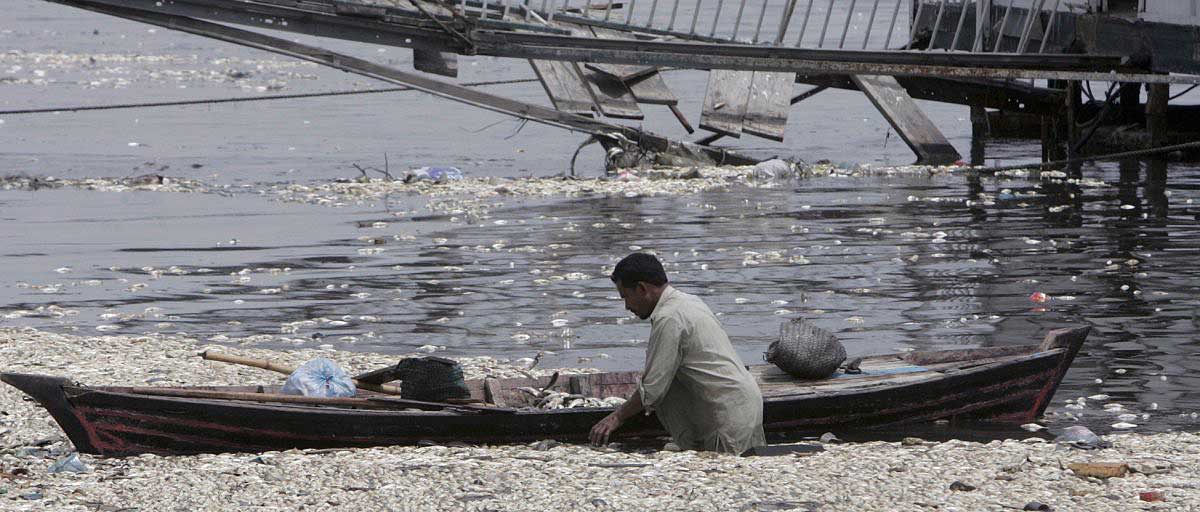
A boy covered in polluted dust, in the north of Pakistan. This is typical for this area, according to a new study which warns that continued use of internationally banned persistent organic pollutants pose carcinogenic threat to children in the areas. Photo: M. Sohail
Bildtext får vara max två rader text. Hela texten ska högerjusteras om den bara ska innehålla fotobyline! Photo: B. Christensen/Azote
CHEMICAL POLLUTION
A dangerous chemical romance
How ongoing use of banned chemicals and extensive deforestation now haunts northern Pakistan, leaving population prone to serious health issues
- Due to lack of regulations many internationally banned chemicals may appear in developing countries
- Researchers discovered alarming recent use of internationally banned persistent organic pollutants (POPs) including DDT in the dust particles in Pakistan posing carcinogenic threat to children
- The POP pollution is further exacerbated by extensive deforestation in the North of Pakistan during the last decade
Regulations for chemical use are often sloppy in developing countries because of high development pressure and lack of awareness and data. In Pakistan, levels of heavy metals such as arsenic and mercury are high above what is considered safe for humans.
Previous research by centre researcher Avit K. Bhowmik and his research team discovered persistent organic pollutants (POPs) in dust particles in Pakistan that were banned in the USA and Europe 50 years ago.
In an article recently published in Science of the Total Environment, they show that the POP pollution is further exacerbated by rapid deforestation in the North of Pakistan. Forests provide important buffers from dust pollution. As a consequence, deforestation releases dust particles and increases human exposure to polluted dust.
Use of internationally banned chemicals
Polychlorinated biphenyles (PCBs) and organochlorine pesticides (OCPs) are the most dangerous forms of POPs. DDT is the most commonly known POP and has been banned in the US and Europe since 1972.
Alarmingly, Bhowmik and his colleagues discovered widespread and recent application of many dangerous PCBs and OCPs including DDT in outdoor dust samples collected from all over Pakistan. The main sources of these notorious chemicals are unregulated use of agricultural pesticides and insecticides for malaria control.
These chemicals pose high risk of exposure to human health. The researchers identified high carcinogenic risk for children when compared the concentration of POPs in dust particles with international human health safety standard.
Internationally banned chemicals often find their way through the slack environmental regulations in the global South. Public availability of information on these pollutants are imperative for pushing policies to the control, prevention and mitigation of chemical pollution.
Avit Bhowmik, co-author
Interaction of POP pollution with land use change
Bhowmik and his research team identified a potential interaction between POP pollution and recent land cover changes in the North of Pakistan.
The risk from POP exposure was found particularly high in the Northern mountainous region of Pakistan, despite it being a region with low industrial and agricultural activity and a limited population.
How could this be?
Bhowmik and his colleagues discovered that the region went through extensive deforestation during the last decades to meet country’s timber demand. 90% of the forest cover in this region disappeared between 2000 and 2010. Forest canopies provide important buffers against many pollutants and similarly against POP polluted dusts. This extensive deforestation led to massive POP polluted dust fall out in this region that were buffered for decades by forest canopies.
Thus, chemical pollution may further be exacerbated by other planetary boundary processes. Transgressing the boundaries for land system change and biosphere integrity lead to the loss of important ecosystem services that protect us from exposure to harmful chemical pollutants.
%20deforestation%20north%20pakistan.png)
Changes in forest cover (green) in the northern mountainous region of Pakistan between 2000 and 2010.
Get on top of the POPs
The message from Bhowmik and his colleagues is simple: stronger regulation and monitoring of the POP application in Pakistan and other developing countries is needed along with the preservation of ecosystem services that provide buffers against these pollutants.
"International development agencies that are working on the provision of better health in developing countries must reveal and take care of this dangerous chemical romance," Bhowmik concludes.
"We need to mobilize more funding for public awareness programs and chemical databases. Global initiatives like Sustainable Development Goals should explicitly address the chemical pollution threat to sustainability in the global South."
Methodology
The researchers collected 110 samples of dust from 19 sites along the Indus river tributary. They measured the concentration of 21 selected PCBs and OCPs in dust samples. Potential human chemical daily intake of POPs through ingestion, inhalation and dermal contact was calculated using the measured concentrations and subsequently compared with the World Health Organization recommended health safety thresholds for adults and children. The sites, where the concentration of POPs exceeded the safety thresholds were mapped as risky sites. The authors also calculated and compared the correlation of POP concentration with several natural (water capacity, pH etc.) and anthropogenic (population density, forest density etc.) variables.
Sohail, M., Eqani, S.A.M.A.., Podgorski, J., Bhowmik, A.K., Mahmood, A., Ali, N., Sabo-Attwood, T., Bokhari, H., Shen, H., 2017. Persistent Organic Pollutant emission via dust fallout throughout Pakistan: Fingerprinting of recent inputs, regional cycling and their implication for human health risks. Science of The Total Environment in press. https://doi.org/https://doi.org/10.1016/j.scitotenv.2017.08.224
Avit Bhowmik is a postdoctoral researcher at the centre. His main research concerns cross-scale social-ecological dynamics, tipping processes, and their interactions in the human dominated epoch - the Anthropocene







